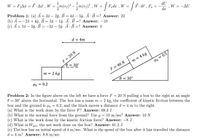Question
thumb_up100%

Transcribed Image Text:w = FjAc = F .Aë , W = m(v;)* - m(u,)* , v
1
zm(us)* - m(v,)* , W =
Problem 1: (a) Ã = 3â – 2ŷ, B = 4â& – 5ŷ. Ã ·B =? Answer: 22
(b) Ã = -2â + 4ŷ, B = 3âu – lŷ. Ā·B =? Answer: –10
(c) à = 5â – 3ŷ, B = -3â – 5ŷ. ÷B =? Answer: 0
1
| F,dx , W =
F. dř , F,
dU
W = -AU
dx
d = 4m
F = 20 N
0 = 30°
m = 4 kg
Hk = 0.5)
m = 2 kg
F = 40 N
Hk = 0.2
Ө — 30°
Problem 2: In the figure above on the left we have a force F = 20 N pulling a box to the right at an angle
0 = 30° above the horizontal. The box has a mass m = 2 kg, the coefficient of kinetic firction between the
box and the ground is uk = 0.2, and the block moves a distance d = 4 m to the right.
(a) What is the work done by the force F? Answer: 69.3 J
(b) What is the normal force from the ground? Use g = 10 m/sec² Answer: 10 N
(c) What is the work done by the kinetic friction force? Answer: -8 J
(d) What is Wnet, the net work done on the box? Answer: 61.3 J
(e) The box has an initial speed of 4 m/sec. What is the speed of the box after it has travelled the distance
d = 4 m? Answer: 8.8 m/sec
||
Expert Solution
This question has been solved!
Explore an expertly crafted, step-by-step solution for a thorough understanding of key concepts.
Step by stepSolved in 2 steps

Knowledge Booster
Similar questions
- 6-1)arrow_forwardOne mole of Gold (Au) atom has a mass of 197 g. We know that the density of gold is 19.30 g/cm3 in room temperature. Using those numbers, answer the following questions: a) What is the mass of a single gold atom in kg? b) Assume that gold atoms sit in a perfect cubic crystal structure. Estimate the distance between two gold atoms in meters. c) If we have a gold cube of 6 cm on each side, how many atoms can we fit along the edge of each side of the cube? d) What would be the mass, in kilograms, of the gold cube we discussed in part (c) (measuring 6 cm on each side)?arrow_forwardP2 = 50 Pa U, = ??? P1 = 200 Pa Ah =10 m υ, 10 m/sarrow_forward
- A gram is Select one: а. 10^-6 kg b. 10^3 kg с. 1 kg d. 10^-3 kgarrow_forward12. Find o (in degrees). y hip (1.1, 0.8) knee (1.35, 0.51) ankle (1.21 0.15) (0, 0)! X Copyrighte 2015 Woltes Kluner - All Rights Reservedarrow_forwardHere's how gym membership works for a potential customer: If the customer decides to join the gym, she will pay J on day 0. Then, she can use the gym starting the next day for 5 days (1; 2; 3; 4; 5), paying an additional F on each day she visits. If she goes to the gym on any given day, it costs her (10+ F) that day, but beneÖts her 30 the next day. In other words, her "costs" are a sum of her psychic costs (10) and actual Onancial costs (F). Assume that, when indi§erent, the individual will go to the gym. (a) Suppose the potential customer is a standard exponential discounter with a discount factor of = 12. If gym membership was free (i.e. J = 0 and F = 0) would she join the gym? If so, how many days would she actually go? (b) Suppose the gym did not charge a joining fee. How high could it set the usage fee? What would its revenues from this customer be? (c) Suppose instead the gym decided not to charge a usage fee. How high could it set the joining fee? [Hint: To Ögure out the…arrow_forward
arrow_back_ios
arrow_forward_ios